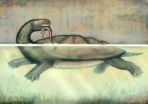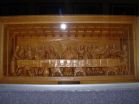(Press-News.org) A decade after the start of the wars in Afghanistan and Iraq, studies have shown that the incidence of post-traumatic stress disorder (PTSD) among troops is surprisingly low, and a Harvard researcher credits the drop, in part, to new efforts by the Army to prevent PTSD, and to ensure those who do develop the disorder receive the best treatment available.
In an article that appears in the May 18 issue of Science, Professor of Psychology Richard J. McNally says there is reason for cautious optimism when it comes to the prevalence of PTSD. While early estimates suggested as many as 30 percent of troops might develop PTSD, current surveys show the actual rates ranging from 2.1 to 13.8 percent. The most rigorous survey of American troops found that 4.3% of all American military personnel deployed to Iraq and Afghanistan developed PTSD, and 7.6 of those reporting combat exposure did so.
"As a society we're much more aware of these issues than ever before," McNally said. "That is reflected by the fact that the military and the Veteran's Administration has established programs to ensure soldiers receive the best treatment possible. The title of my article is 'Are We Winning the War Against Post-Traumatic Stress Disorder?' I think a provisional answer to that is, 'Yes, we might be.'"
While part of the drop may simply be that wars are less lethal – in a decade of war in Iraq, fewer than 5,000 American troops were killed, compared to more than 55,000 killed over a similar period in Vietnam – McNally suspect that new efforts by the Army to tackle the disorder sooner, and ensure soldiers receive the best treatment available, may be helping, too.
The suggestion that 30 percent of troops might develop PTSD was based on the findings of the National Vietnam Veterans Readjustment Study (NVVRS), completed in 1990, which found that 30.9 percent of Vietnam veterans showed symptoms of the PTSD. While later analyses brought that number down, the findings served to galvanize Army efforts to address the risk of soldiers developing the disorder, McNally said.
"It's important to remember that simply being deployed carries a great deal of stress," McNally said. "Soldiers miss their family, and those who stay at home essentially become a one-parent family. Difficulties with children, or school or making ends meet – there are all kinds of stressors that have to do with separating families, let along having one member in a war zone. Fortunately, the military has taken steps to help soldiers cope with these stressors in addition to the traumatic combat stressors that can produce PTSD."
That cognizance has emerged in the form of the Comprehensive Soldier Fitness (CSF) program and Battlemind training, programs created, respectively, to help soldiers build the resilience necessary to reduce their risk for PTSD before being deployed, and to treat those at risk of developing the disorder after they return.
"It's not therapy per se, but a preventive intervention to help people put their experiences in perspective," McNally said, of the Battlemind training. "For example, it encourages soldiers to use the sort of emotional bonding that happens within units to reconnect with their families, and to see symptoms like hyper-vigilance not as symptoms of a mental disorder, but as something they need to adjust when they come home. It helps people realize that those things are part of the normal re-adjustment process."
And thus far, McNally said, the evidence suggests that the training has a positive effect. The results of random trials show that, four months after returning home, soldiers who underwent Battlemind training showed fewer symptoms of PTSD and depression than did those who underwent the Army's standard postdeployment program. Unfortunately, no such trials have been conducted with CSF, so it remains unclear what impact, if any, it has on the incidence of PTSD.
Despite such efforts, however, some soldiers will develop PTSD, McNally said.
Those who do will now have access to what are known to be the best treatments for the disorder, including prolonged exposure and cognitive processing therapy.
"Until this initiative, less than 10 percent of the clinical specialists in PTSD used these treatments," McNally said. "These treatments weren't available to veterans of the Vietnam War – they were only developed in the 1990s – and the evidence shows that the longer you have PTSD, the more likely it is that other problems will accumulate. The earlier we can get people into treatment, the quicker we can help them get their lives back together."
INFORMATION: END
WHO: Renee Weber is VP, Consumer Strategy and Research at The Marketing Store Worldwide, one of the largest brand activation, loyalty, and youth and family marketing agencies in the world, leads youth research for consumer products, toys and promotional marketing efforts working with major brands.
Renee is an expert in youth and family. At The Marketing Store, her primary responsibilities are to provide more in-depth understanding of youth/families, youth promotions/product development, help lead consumer-based product innovation and establish The Marketing Store Play ...
Picture a turtle the size of a Smart car, with a shell large enough to double as a kiddie pool. Paleontologists from North Carolina State University have found just such a specimen – the fossilized remains of a 60-million-year-old South American giant that lived in what is now Colombia.
The turtle in question is Carbonemys cofrinii, which means "coal turtle," and is part of a group of side-necked turtles known as pelomedusoides. The fossil was named Carbonemys because it was discovered in 2005 in a coal mine that was part of northern Colombia's Cerrejon formation. The ...
David Cerami, CKBR (Certified Kitchen & Bath Remodeler), owner of Hometech Renovations, Inc. & Let's Face It, Inc., has been selected by Remodeling magazine to join the remodeling Big50. The Big50 awards were presented at a gala dinner at the Remodeling Leadership Conference in Baltimore, MD on May 11, 2012. The 2012 Big50 winners are featured in the May issue of remodeling, a national trade publication read by more than 80,000 professional remodeling contractors.
Each year since 1986, the remodeling Big50 inducts 50 owners of remodeling companies that have ...
Playing make-believe is more than a childhood pasttime. According to psychologists, it's also crucial to building creativity, giving a child the ability to consider alternative realities and perspectives. And this type of thinking is essential to future development, aiding interpersonal and problem-solving skills and the ability to invent new theories and concepts. That has been shown to be a component of future professional success in fields from the arts to the sciences and business.
But can creativity be taught? Prof. Nira Liberman ofTel Aviv University's School of ...
New research by psychologists at three North American universities, including the University of British Columbia, finds that parents experience greater levels of happiness and meaning from life than non-parents.
The findings, which contrast sharply with recent scholarship and popular beliefs, suggest that parents are happier caring for children than they are during other daily activities. The research also suggests that the benefits of parenthood appear more consistently in men and older and married parents.
To be published in the journal Psychological Science, the ...
People have increasing opportunities to participate in genetic testing that can indicate their range of risk for developing a disease. Receiving these results does not appreciably drive up or diminish test recipients' demand for potentially costly follow-up health services, according to a study performed by researchers at the National Institutes of Health and colleagues at other institutions.
The study in the May 17, 2012 early online issue of Genetics in Medicine was done by investigators with the Multiplex Initiative, a multi-center collaborative initiative involving ...
Roanoke, Va. – Fool me once, shame on you. Fool me twice, shame on my parahippocampal gyrus.
Scientists at the Virginia Tech Carilion Research Institute have found that suspicion resides in two distinct regions of the brain: the amygdala, which plays a central role in processing fear and emotional memories, and the parahippocampal gyrus, which is associated with declarative memory and the recognition of scenes.
"We wondered how individuals assess the credibility of other people in simple social interactions," said Read Montague, director of the Human Neuroimaging Laboratory ...
52,000 bluebells were delivered to Sherwood Forest this week which are being planted along the entrance drive. Since 8th May, Center Parcs Conservation Rangers at Sherwood Forest have been planting the bluebells which guests will be able to see when arriving for their forest breaks and departing.
Grown from their seed for three years, the 13,000 pots of native English bluebells filled 26 trollies. They were transported this week from Norfolk, travelling more than 130 miles to their new home at Center Parcs Sherwood Forest.
Chosen for their rarity in ancient woodlands ...
HOUSTON – An experimental drug targeting a common mutation in melanoma successfully shrank tumors that spread to the brain in nine out of 10 patients in part of an international phase I clinical trial report in the May 18 issue of The Lancet.
The drug dabrafenib, which targets the Val600 BRAF mutation that is active in half of melanoma cases, also cut the size of tumors in 25 of 36 patients with late-stage melanoma that had not spread to the brain. The drug also showed activity in other cancer types with the BRAF mutation.
"Nine out of 10 responses among patients with ...
The world's largest religious wax museum turns 25 this year. To honor the anniversary, BibleWalk, the Living Bible Museum located in Mansfield, Ohio is offering the tours for just 25 cents during its birthday week, Aug. 12-17. The museum offers four different tours, a collection of rare Bibles and the world's largest collection of American votive folk-art. This unique art form became stylish in the 1910s among newly arrived immigrants who would collect costume jewelry, hat and tie pins, beads, cuff links, collar studs, coins, and other items, sculpting them into elaborate ...



